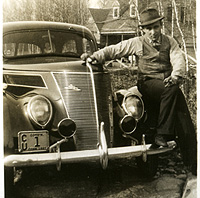
These plates are issued to to pickup trucks, as well as all types of vehicles used for both business and private purposes with a Gross Vehicle Weight Rating up to 12,500 lbs. Up until October 1, 2005, the weight limit was 10,000 lbs.
In 2004, had P.A. 04-199 changed the requirements for issuance of combination plates to pickup trucks. Starting June 3, 2004, non-commercial pickup trucks with a GVWR under 8500 lbs could now display regular passenger plates. Before this, ALL pickup trucks had to be registered with Combination plates.
This type started in 1922, with the same size, colors and format as regular passenger plates but with a ‘C’ prefix. “Comb’n” was first spelled out in 1932. At this time, a stacked 2-letter prefix came into use.
In 1940 these plates took on the same look as regular passenger plates of the time, but always starting with a ‘C’ as the first letter. In 1946 and 1947, the same variations which passenger plates experienced were also applied to combination plates – i.e. some were issued on steel plates, and later brass base metal (in the C/2, C/3 and C/4 series) towards the end of the series.
In 1948, plates were reissued on the new reflective yellow scotchlite base. The reflectorization didn’t hold up well and around 1951 the white scotchlite was introduced. At the very end of this reflective white base the numbering format was expanded to C/A 1234.
See page 2 for the continuation of the history of this type.
Click the photo above to see this type in use.
 1923
1923
Second year for this type.
 1926
1926
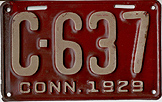 1929
1929
 1932
1932
The type legend was first added in 1932.
3- and 4-digit all numeric combination plates were issued starting in 1932, along with the continuation of the C 123 format. The subsequent format was a stacked C/A 123 format, beginning presumably with C/A 1.
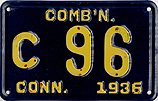 1936
1936
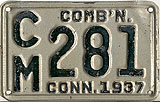 1937
1937
 1938
1938
 1947
1947
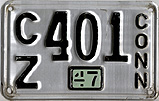 Another 1947.
Another 1947.
Near the end of the numbering series.
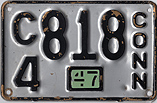 1947 Brass Plate.
1947 Brass Plate.
Brass was used for a very short time, and there are not many Combination plates made on the brass base. Numbers appear to have been in the C/2, C/3 and C/4 series (Possibly also C/5). These plates did not hold up very well.
 Reverse of the 1947 Brass Plate.
Reverse of the 1947 Brass Plate.
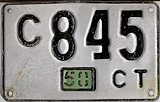 1950
1950
This plate once had reflective yellow sheeting on the background.
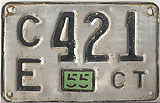 Used until 1955
Used until 1955
Again, missing the yellow scotchlite.
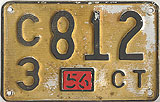 1956
1956
Somewhere around a 1948/1949 plate, revalidated until 1956.
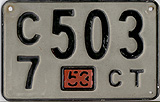 1953
1953
The changeover between yellow and white scotchlite apparently happened between the C/5 and C/7 series.
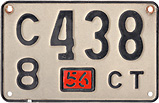 1956
1956